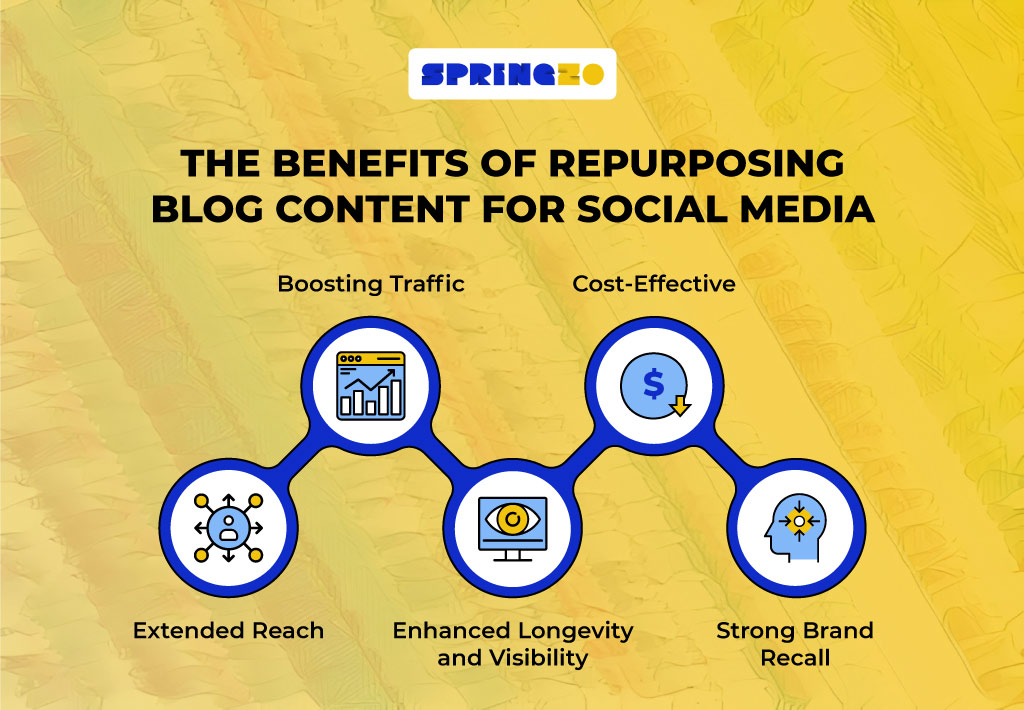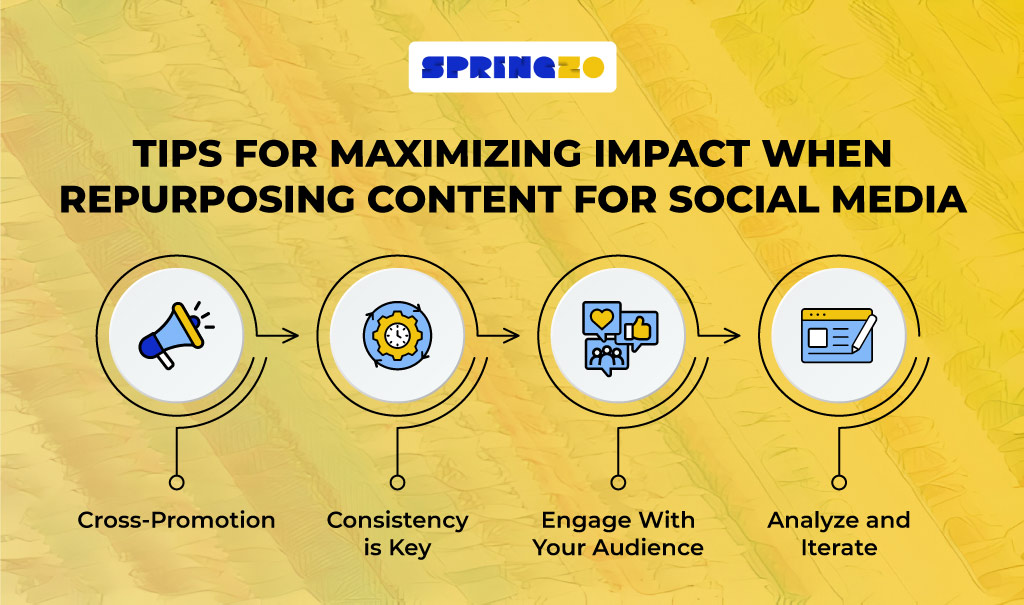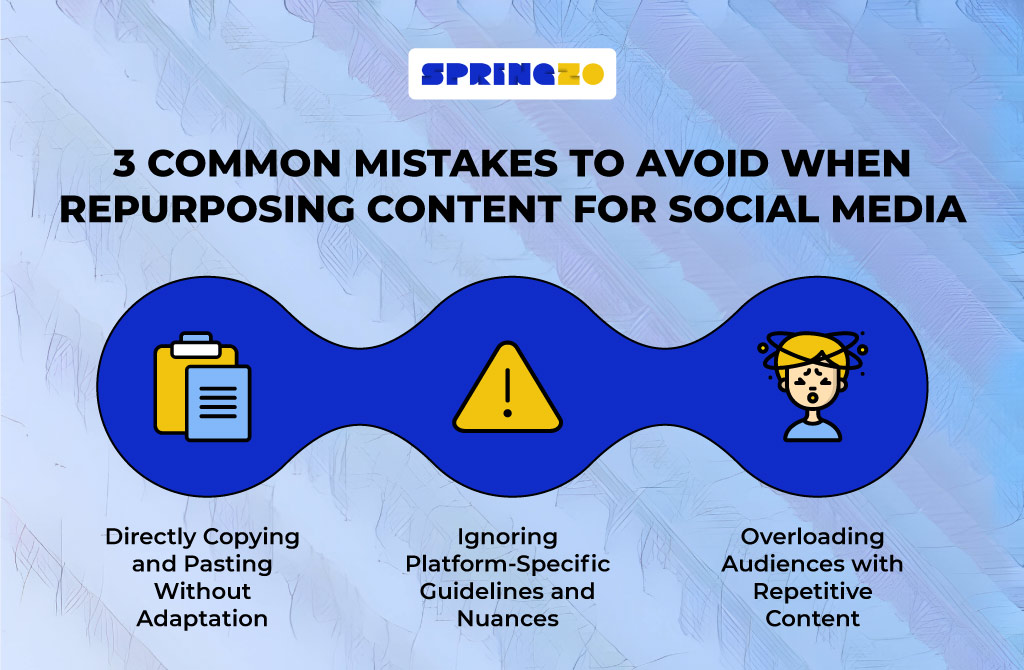Bloggers, digital marketers, content creators, and businesses routinely invest significant time and energy into crafting compelling blog content that resonates with wider audiences. But did you know you can now amplify the strength of that same content, extending its reach far beyond your blog? The answer lies in repurposing content for social media.
Repurposing isn’t just a buzzword—it’s a strategic approach that allows creators to take the content components of their well-thought-out articles and reshape them for various social media platforms.
Therefore, instead of letting your blog posts sit passively on your website, waiting for organic traffic, you can actively distribute your content tailored to the unique characteristics of each social platform. This works like a charm, as your core messages meet diverse audiences exactly where they are most active.
In this blog post, we get into the details of how to repurpose your blog posts into captivating and fresh social media content.
The Benefits of Repurposing Blog Content for Social Media

Let’s delve into the transformative advantages of this approach:
1. Extended Reach to Diverse Audiences
Each social media platform boasts a unique demographic of users. By adapting your blog content for various platforms, you are tapping into different segments of the potential audience, increasing the breadth of your reach.
2. Boosting Website Traffic through Social Referrals
A teaser video on Instagram or a compelling quote on Twitter can intrigue users enough to click through to your main blog post. These incremental visits not only bolster your organic traffic stats but can lead to higher engagement rates and conversions on the website.
3. Enhancing the Longevity and Visibility of Your Content
A blog post might see peak traffic for a few days post-publishing, but what then? It often slowly dies out with time. On the other hand, by repurposing content for social media, you breathe new life into your articles, ensuring they remain in circulation and are seen by fresh eyes over an extended period.
4. Cost-effective Way to Maximize Content Production Efforts
High-quality content requires resources, be it time, effort, or money. Repurposing allows you to maximize the ROI on your initial investment, ensuring each piece of content is leveraged to its fullest potential across multiple platforms.
5. Reinforcing Your Brand Messaging across Multiple Platforms
Consistency is key in brand messaging. By sharing tailored versions of your blog content across various social media channels, you’re reinforcing your brand’s voice, values, and messaging, leading to stronger brand recall and loyalty.
Adaptability, innovation, and maximization are the order of the day—and repurposing sits at the heart of this modern content ethos.
How to Effectively Repurpose Blog Content for Social Platforms

Mastering the art of repurposing content for social media is more than merely reproducing the same piece in different sizes or lengths. Here are some strategies you can adopt:
1. Identifying Key Points and Takeaways
First things first: break down blog posts into bite-sized pieces before you begin repurposing. This allows you to offer digestible content chunks suitable for the fast-paced world of social media, ensuring readers can grasp your message quickly.
Also, distill your article down to its most impactful points. This ensures that even if someone only sees one piece of your repurposed content, they get a valuable takeaway that could hook them immediately, leading to enhanced brand discovery.
2. Choosing the Right Format
Content comes alive when delivered in the format best suited for its message and the platform’s audience:
Graphics: Infographics, charts, and visuals can convey complex ideas swiftly and aesthetically, making them perfect for visual platforms like Instagram or Pinterest.
Videos: Clips, animations, or slideshows can bring a dynamic element to your content, often resulting in higher engagement rates.
Quizzes/Polls: Turning insights from your blog post into interactive quizzes or polls can significantly boost audience participation.
Short and catchy snippets or quotes: Perfect for platforms like Twitter, these can serve as teasers that drive traffic back to your main article.
3. Tailoring for Each Social Media Platform
Each social platform has its own set of unwritten rules and preferences. Successful repurposing requires understanding and respecting these nuances:
Formatting for Instagram: The platform prizes visual-centric content. Convert your insights into graphics, stories, or reels to capture the Instagram audience’s attention.
Adapting for Twitter: Given its brevity-focused nature, break down your content into quick bites, engaging threads, or headlines that can spark interest and retweets. Do not forget to sprinkle humor or a dash of brand-consistent Zeitgeist.
Leveraging LinkedIn: Here, professional insights reign supreme. Convert your content into slide decks or infographics that cater to the platform’s professional audience.
Engaging on Facebook: This versatile platform allows for a range of repurposed content, from sharing your blog as notes, video snippets, or even interactive posts that prompt discussions.
4. Incorporating Interactive Elements
Interactive components not only boost engagement but can also amplify the shareability of your content:
Creating engaging CTAs (Call to Action): A well-placed, compelling CTA can direct traffic, prompt shares, or even ignite discussions.
Including shareable components: Ensure parts of your content, whether graphics or insights, are easily shareable, amplifying your reach.
Making use of social media-specific features: Embrace platform-specific tools, such as Instagram stickers or Twitter polls, to further engage your audience.
Remember, repurposing content for social media isn’t a one-size-fits-all endeavor. It demands a nuanced understanding of each platform and a commitment to delivering value in diverse, engaging ways.
With the right strategy, your blog post can metamorphose into a multi-faceted social media campaign, unlocking unparalleled levels of engagement and reach.
10 Ways to Repurpose Articles into Social Media Content

Here are ten innovative ways to transform your articles into engaging social media content:
1. Infographics
These are visual summaries of your blog content. With the average user’s dwindling attention span, infographics can swiftly convey the essence of your message, making complex ideas both digestible and shareable.
2. Quote Graphics
Every article has a few powerful lines that resonate deeply. Highlighting these quotes in visually appealing graphics can capture attention and stir curiosity about the broader content.
3. Short Video Clips
The digital world loves videos. Convert summaries, animations, or even behind-the-scenes looks from your blog into video snippets. They can be a dynamic teaser, drawing users to delve into the full article.
4. Podcast or Audio Clips
With the rise of auditory media, consider reading aloud or discussing key points from the blog in a podcast format. It offers your audience an alternative, often more intimate, way to consume your content.
5. Twitter Threads
Twitter’s focus on brevity makes it perfect for breaking your article into a series of connected tweets. This segmented approach can provide readers with an informative narrative journey, encouraging them to follow through to the end.
6. Instagram Stories or Reels
The fleeting nature of stories or the dynamic appeal of reels can be utilized for step-by-step guides or quick insights. Their immersive format ensures you have your audience’s undivided attention.
7. LinkedIn Slide Decks
Repurposing content for LinkedIn? Convert your article’s main points into a professional slide deck. This format resonates with LinkedIn’s audience, CXOs, and high-level employees who are constantly looking for in-depth insights in a structured manner.
8. Interactive Polls and Quizzes
Transform facts or insights from your article into interactive elements. These engage your audience actively, prompting them to reflect on your content topic and interact with your brand.
9. Pinable Images for Pinterest
With Pinterest being a visual search engine, design-related images that link back to your blog. Well-crafted pins can drive significant traffic back to your main content.
10. Facebook Live
Go live! Discuss the blog topic, answer queries, and interact with viewers in real time. This format not only humanizes your brand but also fosters a deeper connection with your audience.
Tips for Maximizing Impact When Repurposing Content for Social Media

Here are expert tips to ensure your repurposed content makes a significant impact:
1. Cross-Promotion
Leveraging Blog Audiences: Your blog readership can become a substantial asset for your social media growth. Use your blog as a platform to promote your social profiles, ensuring a symbiotic relationship where each boosts the other.
Reverse Promotion: Likewise, your social media followers can be directed to your blog content. This holistic approach ensures that audiences are always discovering more avenues to connect with the brand.
2. Consistency is Key
Uniform Brand Voice: Whether it’s a tweet, an infographic, or a podcast snippet, maintaining a consistent brand voice ensures reliability and fosters trust.
Consistent Aesthetic: Beyond the voice, your brand’s visual aesthetic should also be coherent across platforms. This visual consistency can make your content instantly recognizable, enhancing brand recall.
3. Engage With Your Audience
Prompting Discussions: When repurposing content for social media, aim for interactivity. Pose questions or encourage discussions related to your content topic, fostering community engagement.
Active Engagement: Responding to comments, direct messages, or mentions can humanize your brand and show your audience that you value their input.
Encouraging Resharing and Tagging: User-generated content, such as shares or tags, can exponentially increase your content’s reach and lend a grassroots authenticity to your brand.
4. Analyze and Iterate
Performance Monitoring: Track the performance metrics of your repurposed content. Platforms offer a wealth of analytical tools that can provide insights into engagement rates, reach, and other vital metrics.
Adapting to Feedback: The beauty of repurposing content for social media lies in its adaptability. Based on audience engagement and feedback, strategies can be tweaked, ensuring you’re always aligned with your audience’s evolving preferences.
In essence, repurposing content for social media is both an art and a science. It requires a blend of creativity, strategy, and data-driven decision-making. With the right approach and consistent efforts, you can transform singular pieces of content into multifaceted campaigns that resonate across platforms and demographics.
3 Common Mistakes to Avoid When Repurposing Content for Social Media

Repurposing content for social media offers immense potential, but like any strategy, there are pitfalls one must sidestep. Awareness of these common mistakes ensures consistent, high-quality content across platforms:
1. Directly Copying and Pasting Without Adaptation
One-size-fits-all is a myth in the world of content creation. Simply copying and pasting your blog content onto social media platforms without thoughtful adaptation misses the mark.
Each platform caters to specific user behaviors, preferences, and engagement patterns. Adapting your content’s presentation and tonality to resonate with these nuances ensures relevance and engagement.
2. Ignoring Platform-Specific Guidelines and Nuances
Beyond the character counts or video lengths, each social platform has its own culture and unwritten codes. Ignoring these subtleties can lead to content that feels out of place or even violates platform guidelines.
Therefore, before repurposing content for social media, invest time in understanding each platform’s unique ethos.
3. Overloading Audiences with Repetitive Content
Overburdening your audience with content that feels too repetitive can lead to fatigue and disengagement. Strike a balance by diversifying your repurposed content and offering fresh angles or insights.
By steering clear of these common mistakes, you position your repurposed content for maximum impact, ensuring it resonates authentically and effectively with your desired audience on each platform.
Wield the Power of Content Repurposing
Transforming a singular blog post into varied social content not only amplifies its reach but also enhances its lifespan, ensuring your efforts garner the returns they deserve. However, like any strategy, the key lies in execution. Repurposing is less about repetition and more about reinvention.
By understanding the unique demands of each platform, ensuring consistency, and continuously engaging with your audience, you can craft a content strategy that’s both innovative and impactful.
At Springzo, we’ve always championed the value of all content and, more precisely, the boundless possibilities that come with repurposing content for social media. With each article, video, or graphic you’ve produced lies an untapped reservoir of potential waiting to be transformed into impactful social media narratives.
Whether it’s reimagining a blog post as a series of engaging tweets, translating insights into eye-catching infographics, or distilling lengthy analyses into bite-sized video segments, our team at Springzo stands at the forefront of this transformative journey. We offer expertise, innovative tools, and a profound understanding of the digital domain, ensuring your content resonates, engages, and delivers.
Reach out to us and experience the Springzo effect on your content marketing!
Frequently Asked Questions (FAQs)
1. How long does the process of repurposing content typically take?
While the duration can vary based on the original content’s complexity and the intended repurposed format, a standard blog-to-social content transformation can take anywhere from a few hours to a couple of days. More intricate formats like video adaptations might require additional time for production.
2. Are there specific tools or software for content repurposing?
Absolutely! Depending on the format and platform, we recommend a range of tools. Platforms like Canva or Adobe Illustrator can be handy for infographics and graphics. For video snippets, tools like InVideo or Adobe Premiere Pro are beneficial.
3. Does repurposed content perform better on certain platforms over others?
The performance often hinges on how well the repurposed content aligns with the platform’s primary audience and engagement style. For instance, visual content like infographics might perform exceptionally well on Pinterest or Instagram, while detailed Twitter threads can garner significant engagement on Twitter.
4. How can I measure the success of my repurposed content?
Monitoring analytics is key. Platforms offer insights into engagement rates, shares, comments, and reach. For a more holistic understanding, tools like Google Analytics can help track referral traffic to your blog or website from repurposed social media content.
5. Is there a risk of audience fatigue with repurposed content?
While repurposing is an efficient strategy, it’s crucial to ensure diversity in presentation and not to repeatedly overload your audience with similar content. It’s about striking a balance between familiarity and fresh, engaging perspectives.
